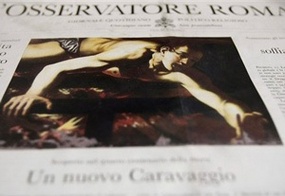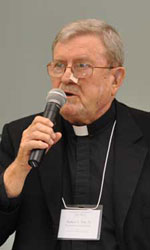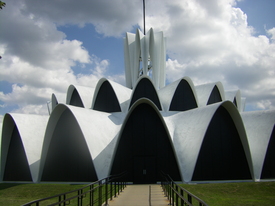 These last 9 days I’ve been in St Louis, MO visiting friends, lay and monastic (including Mrs. Casey!). I periodically return to St Louis the scene of some studies I did at St Louis University between 1994 and 1997. I stayed with the Benedictine monks of Saint Louis Abbey; there I have many old friends.
These last 9 days I’ve been in St Louis, MO visiting friends, lay and monastic (including Mrs. Casey!). I periodically return to St Louis the scene of some studies I did at St Louis University between 1994 and 1997. I stayed with the Benedictine monks of Saint Louis Abbey; there I have many old friends.
When I went to St Louis in 1994 I didn’t expect to meet Benedictine monks as I was fully ensconsed in the life and works of the Society of Jesus. While I did hear of the St Louis monks, I really never thought that a friendship would flower with them. By Divine Providence I met two monks, Fathers Gerard and Gregory, at a consecration of a Coptic Orthodox Church. The monks had some Copts in their school and so being at the church consecration was a natural thing to do and I was there because of my high interest in Eastern Christianity. Plus, who could resist saying you met a pope, the Coptic Orthodox pope, Shenouda? To this day I still get some mileage out that anecdote.
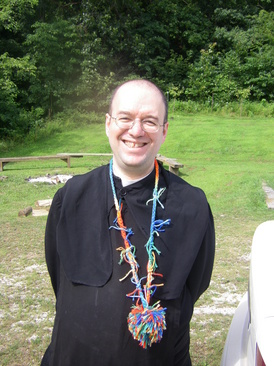
From the providential meeting of the two priests I met other monks with whom I have had the privilge of being friends. Over the years the company has grown and for that grace, I am very grateful.
I haven’t been back to St Louis in the past three years. Since then the city and various suburbs have changed for the better with buidling and/or renovating public places and the like. I love the many new stores and the restaurants. Actually, there are many good eats in the greater St Louis area! But some things remain the same: a people who know each other vs. the terrific annonymity of many east coast cities. Sometimes, I have to say, St Louis is too small….
Time spent at the abbey and with other friends was truly delightful. I went particularly to see Fr Ambrose whom I hadn’t seen in a while and with whom I share many things, not the least being Rome and warm fuzzies. Fr Ambrose is modeling a warm fuzzy in the picture to the right.
I happily had the opportunity to visit with the students of St Louis Priory School making what is affectionately known as “Monkamp” (i.e., 4 days’ introduction to the monastic way of life, or at least the fundamentals of it –prayer, manual labor, community, silence, balance, study and fun); monkamp is a small effort at vocation promotion. At some point I had terrific dinner with a classmate who
 remains in the Gateway City, David Miros, invitations to getting ice cream at Ted Drews (3x), a “drive-by” meeting with Tim Hercules, making an attempt with Fr Ambrose at having a Lebanese lunch at St Raymond’s Maronite Cathedral (instead we went for something equally as exoctic, Indian, as the Lebanese lunch was closed for a month), and the meandering around St Louis University and seeing an old friend who was recently ordained a Jesuit priest, Kevin Dyer, etc. While visiting St Raymond’s I ran into an old friend who told us of the tragic killing of her grandaughter, Gina, a few months ago by teenage muggers. Roxy’s recounting the crime moved me to tears. Pray for Roxy and her family as they deal with the aftermath. Gina, a single mother leaves two sons, one of whom witnesses the brutality of his mother’s murder.
remains in the Gateway City, David Miros, invitations to getting ice cream at Ted Drews (3x), a “drive-by” meeting with Tim Hercules, making an attempt with Fr Ambrose at having a Lebanese lunch at St Raymond’s Maronite Cathedral (instead we went for something equally as exoctic, Indian, as the Lebanese lunch was closed for a month), and the meandering around St Louis University and seeing an old friend who was recently ordained a Jesuit priest, Kevin Dyer, etc. While visiting St Raymond’s I ran into an old friend who told us of the tragic killing of her grandaughter, Gina, a few months ago by teenage muggers. Roxy’s recounting the crime moved me to tears. Pray for Roxy and her family as they deal with the aftermath. Gina, a single mother leaves two sons, one of whom witnesses the brutality of his mother’s murder.
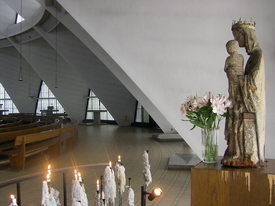
Crucially important for me was the time spent with the monks in their fraternal life. Theirs is a more intense life than many US Benedictine monks in that their day begins with Office of Vigils at 5:35 am and ends with Compline at 7:40 pm with three other parts of the Divine Office, Mass and Lectio Divina integrated into the day complemented with care for the senior monks, house duties, parish and school work. Free time (holy leisure) is not often found, sadly. Besides the
Priory School (junior and high) the monks are the pastors of
Saint Anselm Church, the
Oratory of Saints Gregory and Augustine (the traditional Mass crowd), and a vibrant Oblate program.

Catching up with Brothers Sixtus, Aidan, Mark, Maximillian, Edward, and with Fathers Ambrose, Linus (the newly ordained), Dominic and Bede (for an afternoon), et al, was good for me because I am edified by their witness. These are great men living a vocation that is engaging, attractive, life-giving and lived in order that God be glorified.
Particularly joyful for me was to see Brother Sixtus following his solemn profession of vows, and to see Brother Aidan. In the photo to the left is Br Sixtus and Brother Aidan.
Let us pray to Our Lady, Mediatrix of All Graces and to Saints Louis, Benedict, Scholastica, Walburga, Emma and Gertrude for the monks, their benefactors, Oblates and co-workers & students.
Other pictures found
here.
 These last 9 days I’ve been in St Louis, MO visiting friends, lay and monastic (including Mrs. Casey!). I periodically return to St Louis the scene of some studies I did at St Louis University between 1994 and 1997. I stayed with the Benedictine monks of Saint Louis Abbey; there I have many old friends.
These last 9 days I’ve been in St Louis, MO visiting friends, lay and monastic (including Mrs. Casey!). I periodically return to St Louis the scene of some studies I did at St Louis University between 1994 and 1997. I stayed with the Benedictine monks of Saint Louis Abbey; there I have many old friends. remains in the Gateway City, David Miros, invitations to getting ice cream at Ted Drews (3x), a “drive-by” meeting with Tim Hercules, making an attempt with Fr Ambrose at having a Lebanese lunch at St Raymond’s Maronite Cathedral (instead we went for something equally as exoctic, Indian, as the Lebanese lunch was closed for a month), and the meandering around St Louis University and seeing an old friend who was recently ordained a Jesuit priest, Kevin Dyer, etc. While visiting St Raymond’s I ran into an old friend who told us of the tragic killing of her grandaughter, Gina, a few months ago by teenage muggers. Roxy’s recounting the crime moved me to tears. Pray for Roxy and her family as they deal with the aftermath. Gina, a single mother leaves two sons, one of whom witnesses the brutality of his mother’s murder.
remains in the Gateway City, David Miros, invitations to getting ice cream at Ted Drews (3x), a “drive-by” meeting with Tim Hercules, making an attempt with Fr Ambrose at having a Lebanese lunch at St Raymond’s Maronite Cathedral (instead we went for something equally as exoctic, Indian, as the Lebanese lunch was closed for a month), and the meandering around St Louis University and seeing an old friend who was recently ordained a Jesuit priest, Kevin Dyer, etc. While visiting St Raymond’s I ran into an old friend who told us of the tragic killing of her grandaughter, Gina, a few months ago by teenage muggers. Roxy’s recounting the crime moved me to tears. Pray for Roxy and her family as they deal with the aftermath. Gina, a single mother leaves two sons, one of whom witnesses the brutality of his mother’s murder.


